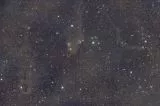- Details
Products description
Experience with 3D dew cap and T2 adapter from Bresser
Hello Mr. Kloß,The shipment arrived safely and soundly.
I'm absolutely thrilled with the 3D-printed dew cap for my Skymax 150 Mak. It's no comparison to the foldable "wobbly cap" from Celestron, which I've had to deal with so far. The fixed dew cap fits snugly and precisely, and with the screws tightened, it doesn't budge at all, even if accidentally touched.
However, the finish along the opening of the inner stop ring could still be improved. The edge has sharp edges (burrs) in places, and the surface is quite rough. But it's definitely something you can live with. Especially since fine-tuning is usually time-consuming and would only unnecessarily increase the cap's truly modest price. If it still bothers you, you can easily remedy the problem yourself with some fine sandpaper.
Regarding the internal blackening of the tube, I'd say: If you're going to the (very commendable!) effort of applying such an elaborate coating with expensive anti-reflective paint, then these blackened surfaces should be better protected afterward. I don't know who or what rubbed or scratched the paint on my dew cap, but I'll probably have to grab a spray can and touch it up a bit. In any case, the positive effect of the anti-reflective paint is partially gone. (see photo attached)
In my defense, however, this "abused" surface is still far superior to the original black plastic skin on the Celestron cap in terms of stray light suppression. Under the same backlight conditions as in the attached photo, the Celestron cap is downright reflective. Despite this minor flaw, the solid cap is an absolute advantage over the Celestron product in this respect as well.
Speaking of stray light suppression: While the M48 extension tubes from Explore Scientific are blackened on the inside, they do so very unevenly and not particularly well, which looks really spotty in backlight.
The T2 extension tubes from BRESSER are only anodized in glossy black, which, of course, makes them even more radiant in backlight. (As expected at this price!) The 5mm tube also has another "quirk." The BRESSER tubes are manufactured according to the conventional design for T2 adapter threads, i.e., with an external thread length of 5mm including the undercut. (The latter, by the way, has a width of a whopping 2mm on these tubes, which is likely due to the simpler manufacturing process.) Due to the short overall length of the 5mm tube, the external thread was left at 5mm, but the internal thread was shortened to 4mm. When screwing onto another sleeve, a gap of 1 mm remains, and the optical length is then not 5 mm but 6 mm (see PDF drawing in the appendix). Within the sleeve assembly, the 5 mm length is only correct if the 5 mm sleeve is positioned at the very beginning, which in turn requires that the external thread of any T2 product screwed on before it can also only be a maximum of 4 mm long, such as the 20 mm T2 extension from TS. However, this extension is not flawless either. While it is not blackened on the inside, unlike the high-gloss BRESSER product, it is at least matte anodized, which significantly mitigates the stray light problem on the internal thread. For some inexplicable reason, however, the inside of the sleeve in the area of the external thread is not provided with an anti-reflective thread, but is completely smooth, which makes the surface almost reflect in backlight despite the matte anodized coating. The Skywatcher 90° 6x30 finderscope displays the same sharp and clear image as its straight-view counterpart. It's also robust and solid, made of metal and glass. It's probably one of the few 6x30 finders that's truly worth its salt. It's still waiting for its first use, and I'm glad that the uncomfortable back and neck strain with the straight-view finderscope is finally over.
So, I hope my feedback hasn't been too long-winded (or boring), and I can assure you that you have a completely satisfied customer in me (despite all the criticism—please take it positively!).
Best regards to Stockdorf
This Product was added to our catalogue on 18/10/2025.
Categories
Quick purchase
Welcome back!
Last viewed:
Manufacturer
Shipping country


